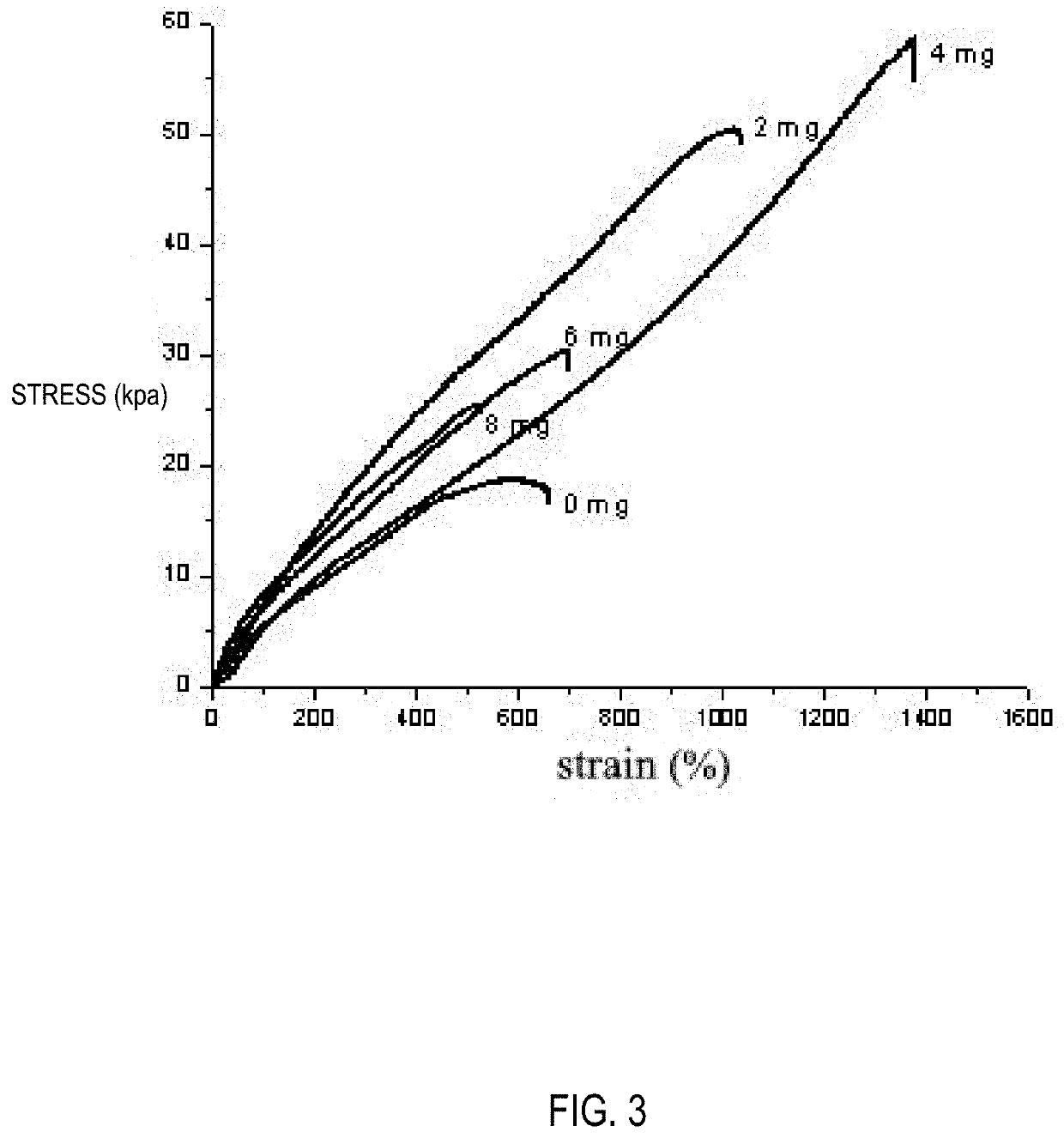All-weather self-healing stretchable conductive material and preparation method thereof
a conductive material and all-weather technology, applied in the field of new materials, can solve the problems of limited hydrogel development, unsatisfactory overall performance, electrical conductivity and mechanical strength of conductive hydrogels that have not yet reached the requirements of humans, etc., to achieve the effect of increasing the cross-linking degree, reducing the self-healing time, and enhancing the tensile strength of the hydrogel
- Summary
- Abstract
- Description
- Claims
- Application Information
AI Technical Summary
Benefits of technology
Problems solved by technology
Method used
Image
Examples
example 1
[0031](1) Dissolving 2 g γ-PGA (white powder having a molecular weight of 10 to 70 w) and 4 g allyl glycidyl ether sufficiently in 25 mL deionized water, adjusting the pH to 2-4 with acetic acid, and stirring at room temperature and effecting reaction for 36 h; then, extracting three times with dichloromethane, and collecting an upper layer of γ-PGAA aqueous solution to obtain a 50 mg / mL γ-PGAA aqueous solution.
[0032](2) Taking 2 g acrylic acid, 4 mL γ-PGAA solution, 4 mg MBAA, 40 mg APS, 0.056 g FeCl3.6H2O, mixing them uniformly in GC:H2O with a volume ratio of 0:6, 1:5, 3:3, 5:1, 6:0, passing nitrogen gas for 30 minutes to remove the gas in the solution, and effecting polymerization at 60° C. for 30 minutes to obtain a composite hydrogel having a different solvent volume ratio. When the content of γ-PGAA solution is 0 mL, the content of FeCl3.6H2O is 0 mg, and the volume ratio of GC:H2O is 0:6, the prepared hydrogel is labeled as PAA hydrogel; when the content of γ-PGAA solution i...
example 2
[0033]As a replacement of step (2) in Example 1, taking 2 g acrylic acid, 4 mg MBAA, 40 mg APS, 0.056 g FeCl3.6H2O, with the ratio of GC:H2O being 5:1, and the γ-PGAA solution was 0 mL, 2 mL, 4 mL, 6 mL and 8 mL, respectively. After the solution was uniformly mixed, passing nitrogen gas for 30 minutes to remove the gas in the solution, and effecting polymerization at 60° C. for 30 minutes to obtain composite hydrogels having different γ-PGAA contents. The remaining steps were the same as in Example 1.
example 3
[0034]As a replacement of step (2) in Example 1, taking 2 g acrylic acid, 4 mL γ-PGAA, 40 mg APS, and 0.056 g FeCl3.6H2O, with the volume ratio of GC:H2O being 5:1, and the mass of MBAA was 0 mg, 2 mg, 4 mg, 6 mg, 8 mg respectively. After the solution was uniformly mixed, passing nitrogen gas for 30 minutes to remove the gas in the solution, and effecting polymerization at 60° C. for 30 minutes to obtain polyacrylic acid and polyglutamic acid composite hydrogels having different MBAA contents. The remaining steps were the same as in Example 1.
PUM
| Property | Measurement | Unit |
|---|---|---|
| resistance | aaaaa | aaaaa |
| thickness | aaaaa | aaaaa |
| width | aaaaa | aaaaa |
Abstract
Description
Claims
Application Information
 Login to View More
Login to View More - R&D
- Intellectual Property
- Life Sciences
- Materials
- Tech Scout
- Unparalleled Data Quality
- Higher Quality Content
- 60% Fewer Hallucinations
Browse by: Latest US Patents, China's latest patents, Technical Efficacy Thesaurus, Application Domain, Technology Topic, Popular Technical Reports.
© 2025 PatSnap. All rights reserved.Legal|Privacy policy|Modern Slavery Act Transparency Statement|Sitemap|About US| Contact US: help@patsnap.com



